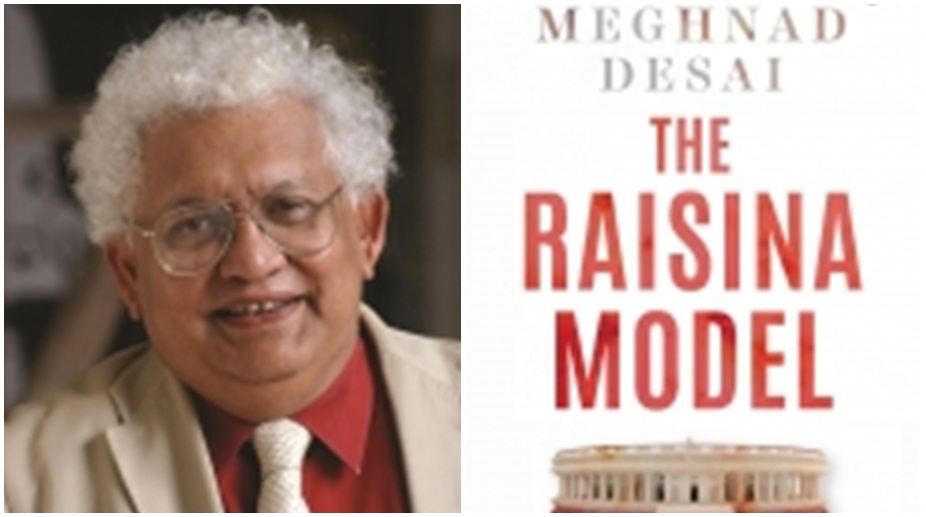Jaishankar refutes claim about global democracy in trouble
Rejecting the concerns about democratic decline, he highlighted the growing voter participation in India, noting that 20 per cent more people vote today than they did decades ago.

The Raisina Model (Photo Credits: IANS)
Book Title: The Raisina Model
Author: Meghnad Desai
Advertisement
Publisher: Penguin Random House India
Advertisement
Pages: 208 pages
Price: Rs 499
Why, despite the differences and the almost continuous trouble in one or other part of India, has the country (India) survived as a single political entity?
The answer in one word is democracy. India’s experiment with democracy has been unique, not only due to the size of the electorate and the number of political parties, but because it has tamed and ‘Indianised’ it. The Westminster model of parliamentary democracy has been transformed into the Raisina model. Reforms to achieve social equality have taken place through the election process-vote banks rather than direct, unilateral executive action which has historically been more common-as for example when Kemal Atatürk reformed Turkey during his tenure as the President.
There is no evidence that democracy existed in ancient India. There were republics in parts of what are now Uttar Pradesh and Bihar. These were territories which had no kings but the rulers were an oligarchy. But these rulers were not elected by all the people. Indeed the idea of equal rights to elect rulers would be strange to a hierarchical social order.
These were oligarchies rather than monarchies, republics rather than democracies. Even in panchayats, whether for a caste or a village, it was very much the older, more powerful men (and exclusively men) who were the panch. We see that today in khap panchayats. Khap panchayats are committees of elders of a jati which lay down the conventions of good behaviour for members of that jati. Democracy is quite different from republicanism. Great Britain has been a democracy without being a republic.
The most radical act of the members of the Constituent Assembly was the decision to grant universal adult franchise. They themselves had been elected by an electorate which was highly restricted. There were several arguments which could have been advanced against universal adult franchise. Illiteracy, for example. Only 12 percent of Indians were literate at the time of Independence. (Now the rate is 75 per cent.) Moreover, across the world, few countries had given women the vote by 1947. The UK achieved full female suffrage only in 1928 and France in 1946. India granted women the vote immediately, without any previous experience of women voting. High or low caste, savarna and Dalits, tribals and mainlanders-all got to vote as long as they were adults. The orthodox theory of Ram Rajya would never have sanctioned such equality. It was a profound, egalitarian move.
The choice of democracy with full adult franchise was not an accident. In the official reforms, franchise had been kept restricted. But the Indian National Congress was converted from an elite gathering into a mass party by Gandhi once he became its leader in 1921. With him at the helm, the Congress gave every ordinary member a right to vote at the local level to elect their representatives in higher Congress bodies. Congress practised universal adult franchise for all its paid-up (4 annas/25 paise) members and then naturally extended it to all when it came to power.
There was also another factor which has been downplayed in the history of the independence movement. This was the experience political leaders acquired by participating in the official legislatures. They included leaders such as Gopal Krishna Gokhale, Sir Srinivas Shastri, Chittaranjan Das, Motilal Nehru, Tej Bahadur Sapru and Vithalbhai Patel, all of whom were seasoned parliamentarians. The electorates were small, the elected Indians had little power, the agenda was controlled by the executive (this still remains the case in independent India’s Parliament). But the participants learnt about procedure on how to frame and pass legislation, debate budgets and so on. The short-term split in the independence movement between the constitutional and the agitational sides took place in 1921, when Gandhi issued the call for non-cooperation, and ended in 1937, when Congress took part in the legislatures.
During that period, the Swaraj Party started by Congress leaders such as C.R. Das and Motilal Nehru participated in the elections. By the time of Independence, in fact, there were many leaders who had become seasoned parliamentarians. Some like Har Bilas Sarda achieved their goal of reforming society by having an Act passed. The Sarda Bill was introduced in 1927 in the Central Legislative Assembly and passed as the Sarda Act in 1929, prohibiting child marriage. India was ready for a parliamentary democracy, British style.
Advertisement